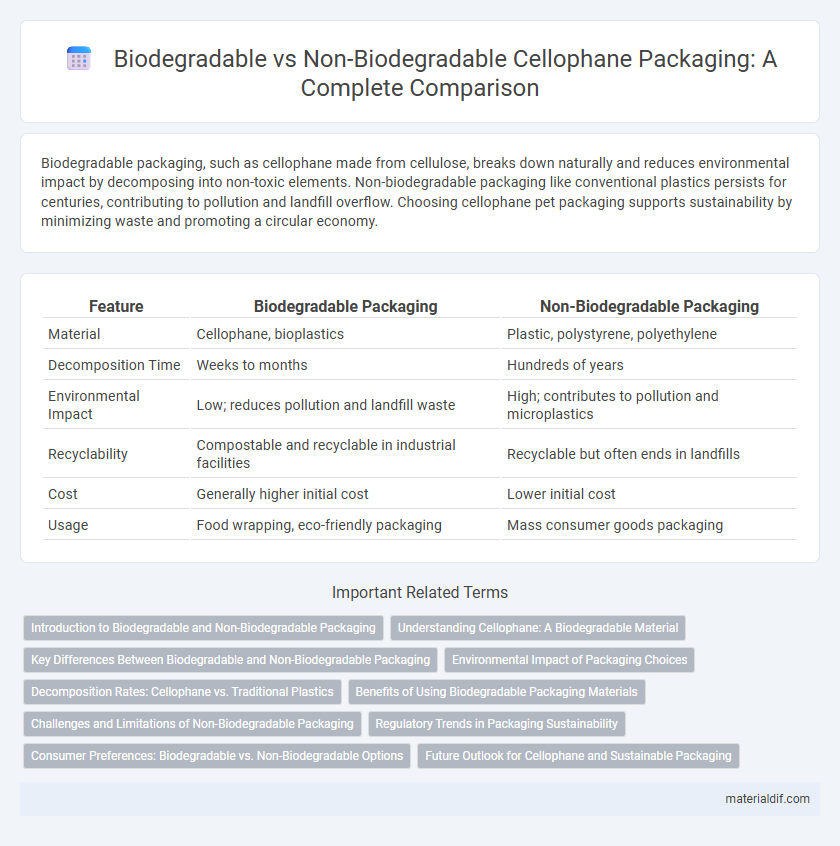Biodegradable packaging, such as cellophane made from cellulose, breaks down naturally and reduces environmental impact by decomposing into non-toxic elements. Non-biodegradable packaging like conventional plastics persists for centuries, contributing to pollution and landfill overflow. Choosing cellophane pet packaging supports sustainability by minimizing waste and promoting a circular economy.
Table of Comparison
| Feature | Biodegradable Packaging | Non-Biodegradable Packaging |
|---|---|---|
| Material | Cellophane, bioplastics | Plastic, polystyrene, polyethylene |
| Decomposition Time | Weeks to months | Hundreds of years |
| Environmental Impact | Low; reduces pollution and landfill waste | High; contributes to pollution and microplastics |
| Recyclability | Compostable and recyclable in industrial facilities | Recyclable but often ends in landfills |
| Cost | Generally higher initial cost | Lower initial cost |
| Usage | Food wrapping, eco-friendly packaging | Mass consumer goods packaging |
Introduction to Biodegradable and Non-Biodegradable Packaging
Biodegradable packaging, derived from natural materials like cellulose, decomposes through microbial activity, reducing environmental pollution and landfill volume. Non-biodegradable packaging, often made from synthetic polymers such as polyethylene and polypropylene, resists decomposition, contributing to long-term ecological harm and waste management challenges. Understanding these fundamental differences is crucial for advancing sustainable packaging solutions and minimizing plastic pollution.
Understanding Cellophane: A Biodegradable Material
Cellophane is derived from cellulose, a natural polymer found in wood pulp, making it inherently biodegradable compared to synthetic plastics. Its ability to decompose through microbial activity reduces landfill waste and environmental pollution associated with non-biodegradable packaging. This renewable resource offers an eco-friendly alternative by balancing functionality and sustainability in modern packaging solutions.
Key Differences Between Biodegradable and Non-Biodegradable Packaging
Biodegradable packaging, primarily composed of natural materials like cellulose or starch, breaks down through microbial activity within months, reducing environmental impact and landfill accumulation. In contrast, non-biodegradable packaging, often made from plastics such as polyethylene or polystyrene, persists for centuries, contributing significantly to pollution and microplastic contamination. The critical differences lie in decomposition rates, environmental sustainability, and the potential for recycling or composting processes.
Environmental Impact of Packaging Choices
Biodegradable packaging, such as cellophane made from cellulose, significantly reduces environmental pollution by decomposing naturally and minimizing landfill waste. Non-biodegradable packaging materials, like traditional plastics, persist in ecosystems for hundreds of years, contributing to soil and water contamination and harming wildlife. Choosing biodegradable options promotes sustainable waste management and reduces the carbon footprint associated with packaging production and disposal.
Decomposition Rates: Cellophane vs. Traditional Plastics
Cellophane, derived from cellulose, decomposes significantly faster than traditional plastics, often breaking down within a few weeks under composting conditions, whereas conventional plastics can persist for hundreds of years. The biodegradability of cellophane reduces environmental impact by minimizing microplastic pollution and accelerating nutrient recycling in soil ecosystems. Traditional plastics, made from petroleum-based polymers like polyethylene and polypropylene, resist natural decomposition, contributing extensively to landfill accumulation and ocean pollution.
Benefits of Using Biodegradable Packaging Materials
Biodegradable packaging materials, such as cellophane derived from cellulose, decompose naturally and reduce environmental pollution compared to non-biodegradable plastics that persist for centuries. These materials enhance waste management by minimizing landfill accumulation and lowering carbon emissions during degradation. Using biodegradable packaging supports sustainable supply chains and meets increasing consumer demand for eco-friendly products.
Challenges and Limitations of Non-Biodegradable Packaging
Non-biodegradable packaging, primarily made from plastics derived from petrochemicals, presents significant environmental challenges due to its persistence in ecosystems that leads to soil and water pollution. The inability to decompose naturally results in accumulation in landfills and oceans, impacting wildlife and contributing to microplastic contamination. Furthermore, the energy-intensive production and recycling processes often generate greenhouse gases, exacerbating climate change concerns.
Regulatory Trends in Packaging Sustainability
Regulatory trends increasingly favor biodegradable packaging such as cellophane due to stricter environmental policies targeting plastic waste reduction. Governments and international bodies implement mandates requiring a shift from non-biodegradable plastics to sustainable alternatives with proven biodegradability and compostability. This regulatory pressure drives innovation in packaging materials, promoting cellophane's use as a compliant, eco-friendly solution aligned with global sustainability goals.
Consumer Preferences: Biodegradable vs. Non-Biodegradable Options
Consumer preferences increasingly favor biodegradable packaging due to environmental concerns and the growing awareness of plastic pollution's impact on ecosystems. Studies indicate that over 70% of consumers are willing to pay a premium for sustainable packaging options like cellophane, which decomposes naturally within weeks compared to non-biodegradable plastics that persist for centuries. Brands adopting biodegradable materials often report higher customer loyalty and positive brand perception, reflecting a shift toward eco-conscious purchasing behavior.
Future Outlook for Cellophane and Sustainable Packaging
Cellophane, derived from cellulose, offers a renewable and biodegradable alternative to conventional plastic packaging, significantly reducing environmental impact. Its future outlook is promising as increasing regulatory pressures and consumer demand for eco-friendly options drive widespread adoption in sustainable packaging solutions. Innovations in cellophane production enhance its barrier properties and durability, positioning it as a key material in transitioning away from non-biodegradable packaging.
Biodegradable packaging vs Non-biodegradable packaging Infographic

 materialdif.com
materialdif.com